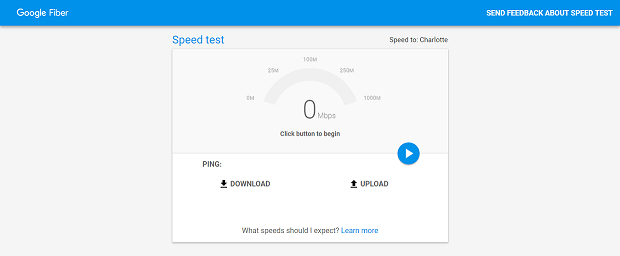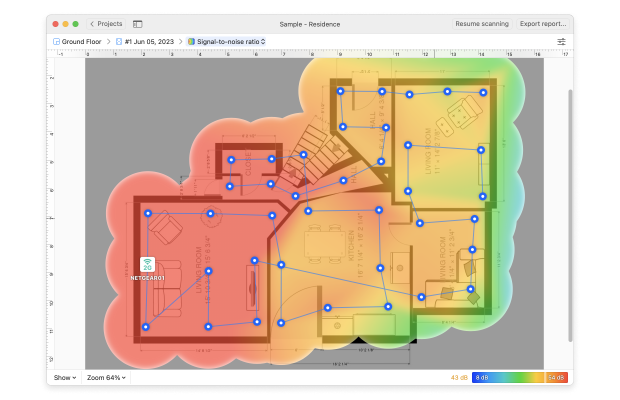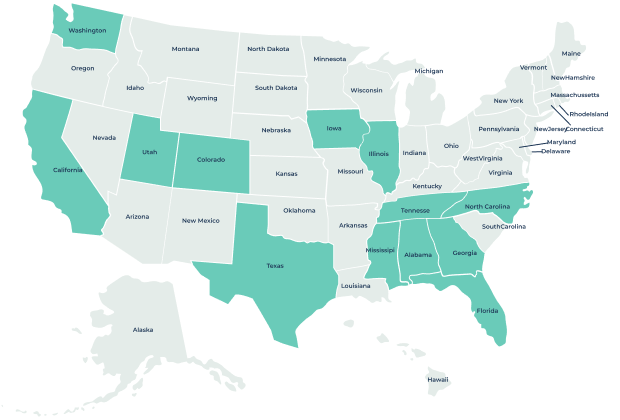Wi-Fi Site Surveys, Analysis, Troubleshooting runs on a MacBook (macOS 11+) or any laptop (Windows 7/8/10/11) with a standard 802.11be/ax/ac/n/g/a/b wireless network adapter. Read more about the 802.11be support here.
Google Fiber Internet Review
Google Fiber is one of the youngest internet service providers in the country. When the service launched in 2010, its promise of affordable fiber-based home internet service seemed almost too good to be true.
Today, Google Fiber internet is available to customers in multiple metropolitan areas, offering two straightforward plans that don't rely on promo prices and various other marketing tactics.
In this review, we’re taking a closer look at this modern service to answer questions such as, “What is Google Fiber?” And “Where is Google Fiber available?” We hope that the answers provided in this article will help you decide if Google Fiber is the right choice for you.
Google Fiber Internet Plans and Pricing
There are only two main Google Fiber plans plus one special plan to choose from:
| Plan | Google Fiber 1 Gigabit |
| Maximum download speed | 1,000 Mbps |
| Maximum upload speed | 1,000 Mbps |
| Promo price** | $70 a month |
| Contract | None |
| Data cap** | None |
| Plan | Google Fiber 2 Gigabit |
| Maximum download speed | 2,000 Mbps |
| Maximum upload speed | 2,000 Mbps |
| Promo price** | $100 a month |
| Contract | None |
| Data cap** | None |
| Plan | Google Fiber Webpass |
| Maximum download speed | 100 Mbps to 1000 Mbps Mbps |
| Maximum upload speed | 100 Mbps to 1000 Mbps Mbps |
| Promo price** | $70 a month |
| Contract | None |
| Data cap** | None |
It’s really refreshing to see an ISP take such a simple approach to pricing, especially considering that some of the providers we’ve reviewed offer more than a dozen different plans, with certain plans often being available only in certain locations.
Best of all, all Google Fiber plans are completely unlimited, and you’re not required to sign any contract to get started.
The more affordable of the two main plans, Google Fiber 1 Gigabit, comes with maximum download and upload speeds of 1,000 Mbps, and it costs $70 a month. The most expensive plan includes twice as fast maximum download and upload speeds for $30 a month more.
Google Fiber Webpass is a special plan for point-to-point wireless internet that you can sign up for if you live in select high-occupancy buildings. Because this internet service is partially transmitted wirelessly, you can experience performance fluctuations due to adverse weather conditions and signal interference.
Unless you have very specific needs, we can guarantee that even the slowest Google Fiber speeds available will be more than fast enough for everything from high-definition steaming to video conferencing to online gaming. Should you ever experience any slowdowns or lag, you should immediately perform a Google Fiber speed test to see if you’re really getting the speeds you should be getting.

If not, don’t contact Google right away. Instead, download a Wi-Fi analyzer app called NetSpot and use it to create a map of your wireless coverage.

Google Fiber Internet Coverage
Google Fiber internet services are available in the following locations:
| Atlanta, GA | Huntsville, AL | Orange County, CA | Salt Lake City, UT |
| Austin, TX | Kansas City, KS/MO | Provo, UT | Seattle, WA |
| Charlotte, NC | Miami, FL | San Antonio, TX | The Triangle, NC |
| Chicago, IL | Nashville, TN | San Diego, CA | West Des Moines, IA (coming soon) |
| Denver, CO | Oakland, CA | San Francisco, CA |
As you can see, Google Fiber locations are limited to select metropolitan areas. In Chicago, IL, Denver, CO, Miami, FL, Oakland, CA, San Diego, CA, San Francisco, CA, Seattle, WA, only Google Fiber Webpass is available.

When Google Fiber was first announced, expectations were set for rapid expansion. For some time, Google Fiber availability was improving at a brisk pace, but the expansion came to a screeching halt when the company suddenly announced an immediate pause on all fiber-optic projects in 2016.
The reason why the Google Fiber coverage map is so sparsely populated likely has everything to do with how much it costs to run new fiber-optic lines. Back when the service launched in 2010, there wasn’t much competition, so the potential return on investment was much higher.
Unfortunately for Google, competing ISPs like AT&T Fiber, Spectrum, and Verizon Fios refused to let it dominate the market, and they now offer gigabit internet speeds in many areas where Google would probably otherwise have expanded already.
The good news is that the Google Fiber availability map is becoming busier and busier. In fact, the provider’s customer base increased by 100% from 2016 to 2020, largely thanks to innovative deployment techniques known as nanotrenching and microtrenching.
Soon, there will be a new dot on the Google Fiber map as the provider prepares to launch its internet service in West Des Moines, Iowa.
Google Fiber Internet Fees & Bonuses
Google Fiber may just be the most straightforward internet service we’ve ever reviewed. Regardless of which plan you choose, there are absolutely no hidden fees or contracts to worry about, and your speeds won’t come to a crawl even if you decide to download the entire Wikipedia.

The only time when you may be asked to pay extra money is if you forget to return the Google Fiber Wi-Fi system, which every new customer can get for free. The system consists of one or more Google Fiber routers, which work together to form a mesh network, allowing your devices to roam from room to room without disconnecting.
You can also expect Google to install the necessary Google Fiber modem (technically an Optical Network Terminal). The purpose of the modem is to convert the fiber signals (light) into electrical signals.
Google Fiber internet can be bundled with TV (YouTube TV, fuboTV, and Sling) and phone services (Google Fiber Phone). Unfortunately, the same bundles are not available to Google Fiber Webpass customers.
Google Fiber Customer Service & Satisfaction
You can get in touch with Google Fiber’s customer service by:
- Dialing Google Fiber customer service numbers: (866) 777-7550 or (855) 418-8326
- Sending an email message
- Visiting your local Google Fiber store
- Using the online chat feature feature
- Sending a direct message on X
- Messaging the company on Facebook
There’s not much data available to objectively determine the quality of Google Fiber customer service.
The best we can do is analyze Google Fiber reviews:
As you can see, Google Fiber reviews range from delighted to displeased. It seems that real users of the internet service complain mostly about Google Fiber support, installation, and billing issues — the usual stuff.
Finding someone who isn’t satisfied with their Google Fiber internet speeds is much, much harder, and we suspect that most customers who are not satisfied with Google Fiber performance have not used NetSpot to find the best place and settings for your Wi-Fi router.
Summary
Google Fiber is a modern fiber-optic internet service that stands out with its straightforward plans that don’t hide any unpleasant surprises in the form of additional fees, data caps, or restricting contracts.
Unfortunately, the service is available only in select metropolitan areas, and some of the most populated cities in the United States, such as New York/New Jersey, Philadelphia, are still not covered Los Angeles, and it will probably take some time before they will be — if ever. But if you’re lucky and live in an area where Google Fiber is available, then don’t hesitate to give it a try because Google Fiber’s cost is hard to beat.
FAQ
While the availability of Google Fiber has improved in recent years, it’s unlikely that the service will ever be available everywhere.
Google Fiber prices are straightforward and devoid of hidden fees. The Google Fiber 1 Gigabit plans costs $70 a month, while the Google Fiber 2 Gigabit costs $100 a month.
Yes, all Google Fiber plans are completely unlimited, so you can download and upload to your heart’s content.
Google Fiber Wi-Fi is a WiFi-6 enabled mesh system that can cover a large apartment or house with a strong Wi-Fi signal.
The Google Fiber internet service can reach speeds of up to 2,000 Mbps, which is theoretically enough for 400 simultaneous Netflix streams.
